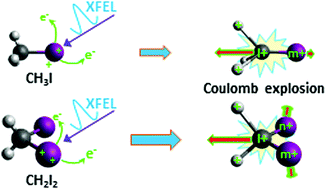Ultrafast Coulomb explosion of a diiodomethane molecule induced by an X-ray free-electron laser pulse†
Abstract
Coulomb explosion of diiodomethane CH2I2 molecules irradiated by ultrashort and intense X-ray pulses from SACLA, the Japanese X-ray free electron laser facility, was investigated by multi-ion coincidence measurements and self-consistent charge density-functional-based tight-binding (SCC-DFTB) simulations. The diiodomethane molecule, containing two heavy-atom X-ray absorbing sites, exhibits a rather different charge generation and nuclear motion dynamics compared to iodomethane CH3I with only a single heavy atom, as studied earlier. We focus on charge creation and distribution in CH2I2 in comparison to CH3I. The release of kinetic energy into atomic ion fragments is also studied by comparing SCC-DFTB simulations with the experiment. Compared to earlier simulations, several key enhancements are made, such as the introduction of a bond axis recoil model, where vibrational energy generated during charge creation processes induces only bond stretching or shrinking. We also propose an analytical Coulomb energy partition model to extract the essential mechanism of Coulomb explosion of molecules from the computed and the experimentally measured kinetic energies of fragment atomic ions by partitioning each pair Coulomb interaction energy into two ions of the pair under the constraint of momentum conservation. Effective internuclear distances assigned to individual fragment ions at the critical moment of the Coulomb explosion are then estimated from the average kinetic energies of the ions. We demonstrate, with good agreement between the experiment and the SCC-DFTB simulation, how the more heavily charged iodine fragments and their interplay define the characteristic features of the Coulomb explosion of CH2I2. The present study also confirms earlier findings concerning the magnitude of bond elongation in the ultrashort X-ray pulse duration, showing that structural damage to all but C–H bonds does not develop to a noticeable degree in the pulse length of ∼10 fs.

- This article is part of the themed collection: XUV/X-ray light and fast ions for ultrafast chemistry


 Please wait while we load your content...
Please wait while we load your content...